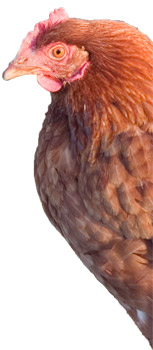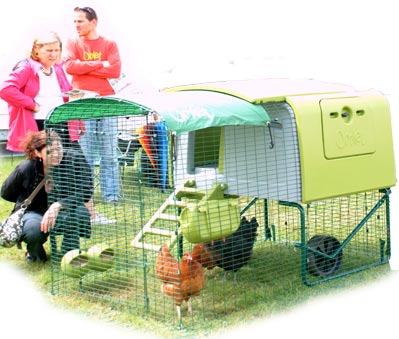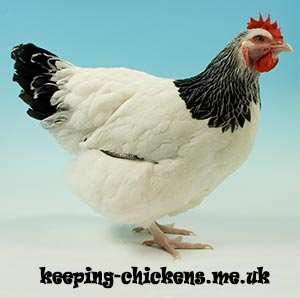Keeping a few chickens in the back yard really is quite straight forward; however there are some things to consider in order to get the right sort of birds for your situation and to keep them in the best possible health to get the most enjoyment out of keeping them.
This page hopes to get you thinking about the types of chickens and their requirements.
Choosing a breed
There are quite literally hundreds of different breeds of chicken to choose from and out of these, many have slightly different requirements.
Some breeds of chicken come only as Large Fowl, and others are also available as Bantams which are a smaller version that look the same. The Orpington for example is available in both large and bantam sizes but the Cochin is only available as large fowl.
There are a handful of ‘True Bantams’ where there is no large fowl equivalent. Examples of these are Dutch Bantams, Japanese Bantams and the popular Pekin Bantam.
Bantams tend to be quite flighty whereas the heavy breeds of large fowl often cannot fly more than a few inches off the ground. Orpingtons for example won’t usually roost very high due to their huge size and will usually just huddle on the floor of the coop.
Every breed is slightly different in the amount of eggs they lay. Typically hens that have been bred for exhibition purposes do not lay as well as utility hens. Bantams of course lay smaller eggs which some people say they prefer for taste.
Hybrids
 Hybrids are chickens that have been created by crossing pure breeds. They are typically crossed to make good layers (the hybrid to the right can lay 280 to 300 eggs!), coloured eggs or attractive hens. Some can be very attractive and they are all generally very hardy. Hybrids are produced in larger numbers that pure breeds and most of the crosses used make the males a different colour as day old chicks so that only females can be raised, therefore reducing costs by about half. A typical hybrid hen will cost you around £15 compare to £25 to £30 for a typical pure breed hen.
Hybrids are chickens that have been created by crossing pure breeds. They are typically crossed to make good layers (the hybrid to the right can lay 280 to 300 eggs!), coloured eggs or attractive hens. Some can be very attractive and they are all generally very hardy. Hybrids are produced in larger numbers that pure breeds and most of the crosses used make the males a different colour as day old chicks so that only females can be raised, therefore reducing costs by about half. A typical hybrid hen will cost you around £15 compare to £25 to £30 for a typical pure breed hen.
Hybrids are a good choice if eggs are one of your priorities although if you think you might like to hatch some eggs, remember hybrid hens do not breed true – you would need the original pure breeds to cross again in order to create more of the same thing so whilst you can hatch their eggs, you may want to consider a few pure breeds for this purpose or consider buying in eggs to hatch.
Free Range
You will of course need a chicken coop but also a secure run or area that is predator proof. A question that people always ask me is “How big should their run be?” I always say “as big as possible within reason.” Even 2 chickens kept in a 2 meter run will soon turn it to mud and get bored (which can introduce vices such as feather pecking and egg eating) but I always believe that it’s fine to provide a small run like this if you can let them out for a few hours each day to free range while you are around. This will give them a chance to forage, supplement their diet and reduce boredom.
Once chickens have settled into their new house, they will go back to it to roost every night so you can let them out in the late afternoon, knowing they will come back to roost at night keeping everyone happy! Some houses and runs have handles or wheels that make them easy to move onto fresh ground which is not only good to prevent a build up of worm eggs and disease but also provides them with a little fresh grass to graze.
Keeping Chickens in the Garden
If you have a ‘nice’ garden that you don’t want spoilt, it’s usually a sensible idea to limit their foraging. Chickens scratch at the ground, make dust baths in the dry soil, leave muck wherever they go and destroy tender young plants. If you can plant in pots, this will help and fencing off part of the garden is usually a good choice to keep them out if you have tender or precious plants. Chickens with feathered feet scratch less and bantams can clear a 6 foot fence if they want to. Heavy breeds of large fowl can be kept out with a knee high fence or box hedge. If you want to stop a bird from flying then you can clip one wing (not both).
So you have decided on the breed that’s right for you and your circumstances. Next, you will need to think about keeping them secure from predators in a suitable chicken house and chicken run – click on a link to go to that page!








hi i have a chick that’s about 1-2 weeks old its a booted splash pekin and my friend is currently looking after it with her new chick in a brooder box im taking it home at Christmas when it is old enough to be out of the brooder box one of her chickens went broody she tried to put mine under her but the female just kept Peking and seriously hurting my chick. my chick has already learnt how to drink and eat on its own but when i take it home will it still be able to survive without having a mum
thank you
just to let you know your website has already helped me so much!
It is best to let the hen raise her since they will have a strong bond. Taking the chick away from the mother will cause the chick to keep calling for her. It is also unfair to raise just one on its own since they are flock animals. I would raise the chick with the hen and then look to purchase a couple of friends for her of the same age.
Hello, I am new to this hobby, I shall be buying some chickens in to following weeks, as we are moving house that has an exsisting brick chicken pen and many runs not to mention the huge garden they will have to run around in. There is a 6ft fence around the garen and although it may stop the FOX the Buzzards and Eagles no doubt will think if these chicks/Hens as easy pickings hmmmm Englishman living in south France thinking for the first time about buying a gun ! OK now I have and will be asking many questions once the chicks arrive, I will also be contacting a very old friend and his wife too Mr & Mrs Alexander from Cheshire, for they first got me into seeing how wonderful Bantams are and Both the formentioned are well respected with in the chicken world in England. Mr Alexander has won many prizes for showing his birds and he Judges the competitions too. So i shall be ringing them up for much needed advice.
This website i have saved to favourites as i will no doubt be needing alot of advice and certainly cheaper than calling good old Friends back in the UK. I with to thank you for creating this site for me it is going to be very very useful…. Fianlly IF Mr & Mrs Alexander read this message i do appologise for not having been in touch sooner, but once our birds arrive you will be fed up to the back teeth of our phone calls, and one more thing I wish to thank my friends who gave me the notion of bird keeping, they have such wonderful birds them selves and well caredfor and YES i shall be sending photos to you lol ty ty all again steve ex cheshire now Vive la france and all the garlic one can eat but not snails please
Hi, I bought 2 Sablepoots & 2 Sussex about 2 months ago and they all getting along fine. I have a decent size garden that I have secured and there is a field behind my garden. I let the girls out as often as I can but only when I can watch them (which will only be at weekends now the nights are drawing in). I am concerned that the cat from down the road may show up as he has shown an interest in them and as the girls are not fully grown I’m frightened that he may attack them! Would it be safe to let them loose for a few hours unattended? ( I would be at home just not sat in the garden) Also what is the best material to use for a bath? I have been told sand is good?
I have never had any problems with cats but I have heard of the odd fatality with small chickens and cats. It is difficult to say really but I would be there when the cat shows an interest and see if it does leave them alone first.
We have been thinking about getting three chickens, would a 14sq foot run be enough space if we let them out to exersise for a few hours in the afternoon?
Also, many thanks for such a great website. Extremely helpful.
I would think it would be ok if you let them out of there regularly, obviously the more free range they get the better.
I will be getting my first few hens in the next couple of weeks. I have a decent sized garden and a small empty field for them to roam. However should I be worried about my hens wondering out on to the road and getting squashed…? Thanks.
It’s hard to say without seeing your setup and to be honest, I haven’t ever had my hens going near a road. Hens do not normally get run over, most of the time they aren’t interested in tarmac but the greener things in life 😉
I would see how they get on, watch them and see how it goes…and if the road is busy or they are wandering too close, I would consider fencing…
I’ve not even said “Why did the Chicken Cross the Road?” have I… well it’s probably to forage in the hedgerow on the other side rather than anything else you hear.
I have 3 semi bantums about 6 months old. I have clipped their wings but they are still going up onto a 6 foot fence (and my neighbours shed) every night to sleep rather than their house. I am not home before this happens (which will change in a few weeks when it gets lighter). Is there anything I can to do to encourage them to go into there house? (we are also hitting -4C temperature at night).
You should only clip one wing to unbalance them rather than both when they will still be able to fly if they flap harder..
Without being there or being able to catch them when you get home and put them in, it’s a little difficult. They normally follow routine so you may need to keep them in their run for a while to get them used to roosting in their house for a few weeks.